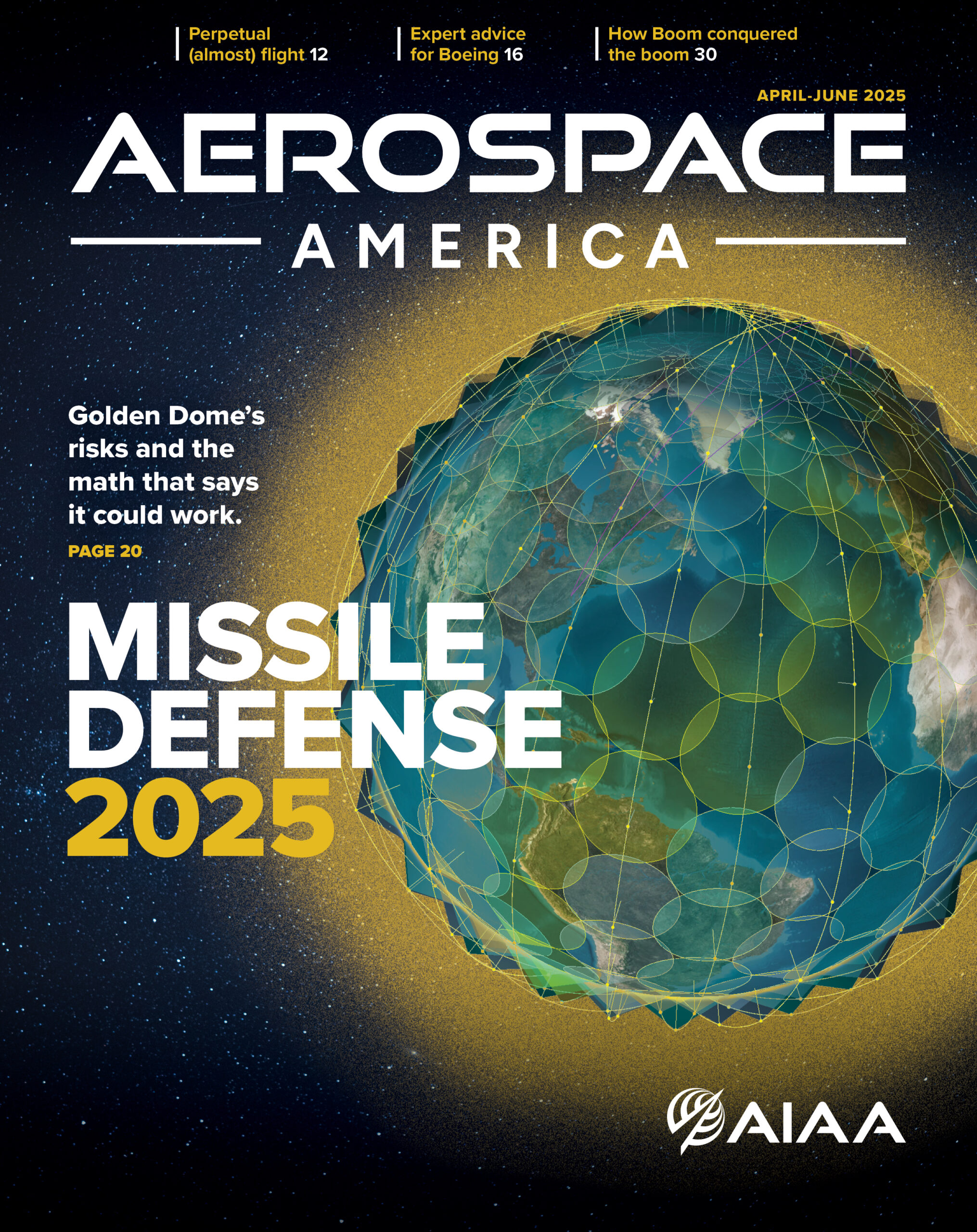Stay Up to Date
Submit your email address to receive the latest industry and Aerospace America news.
Not all research and development is created equal. In few places is that more evident than in the rapidly evolving domain of space, where today’s breakthroughs are frequently the culmination of decades-long research and studies.
In the U.S., the Trump administration has proposed increased funding for bold human spaceflight initiatives including NASA’s Artemis moon program that aims to land the first crew on the lunar south pole as soon as 2027. On the defense side, the Pentagon is set to receive a budget exceeding $1 trillion in fiscal 2026, a historic increase likely to accelerate near-term technological gains. At the same time, the White House has proposed cutting, by roughly one-third, basic research funding for NASA, the National Science Foundation and other civilian agencies.
China, which has its own lunar ambitions, has embraced a very different approach, adding millions in R&D funding every year. It spent roughly $500 billion last year, $35 billion of which was for basic research, according to the country’s National Bureau of Statistics — an 8% overall increase from 2023 and a 10.5% jump for basic research.
Amid the rebalancing of U.S. budgetary priorities, can the commercial sector take up the mantle to drive innovation? Four experts with experience in government, industry and academia weighed in.

Where China has a strategic advantage — and I’m seeing it across the civilian, military and commercial sectors — is that they actually have identified space as a key strategic technology that requires priority funding. President Xi Jinping talks about it at the National People’s Congress. He meets the different scientists. He has directed long-term policy planning and thinking. This has resulted in the China National Development and Reform Commission recognizing satellite internet and other related technology like artificial intelligence, quantum as critical infrastructure.
That means three things: One, that particular technology will have priority funding and long-term funding, even if there is a dip in the Chinese economy. Second, when you declare something a critical infrastructure, it receives the highest level of deterrence and defense. So, in case such assets are targeted, China would view that as a threat to their capability to continue economically and respond in some manner. It could be a cyberattack, it could be some level of nonkinetic attack. Finally, they’re going to pass laws and regulations that declare long-term allocation of skill sets, sign MOUs with universities to develop that and long-term planning.
In the U.S. it seems like we do not explain what we mean when we categorize a particular technology as strategically vital. It’s one thing to say that a space technology is vital for U.S. national security, but it’s something else when you are actually scaling it up to the White House and congressional level. That says that without funding these particular missions and activities, America and the way America’s future is going to unfold will be affected. It’s a very different way of thinking.
I would argue that basic science and research are extremely vital when it comes to building capacity. So even when we are thinking about human spaceflight — long-term, not the short-term programs we had during the Apollo era — or we are thinking about, say, human missions to the moon and Mars, it’ll also require a lot of effort to actually support those missions. In some sense, investment in scientific capacity engineering will play a vital role.
The interesting thing about China is while they’re investing in pure science, they’re always doing so within that larger structure of national defense. Because of that, their funding is very much determined by the concept of strategic technologies. In the U.S., what I find fascinating is that when you actually do a much more comprehensive study beyond just say, looking at NASA, it seems like across different administrations there has been a growing focus on building some of the capacities.
Take the Golden Dome missile defense shield. The White House has proposed increasing the budget for the Space Force. Also, I don’t think people realize that the Department of Defense under several initiatives like the Air Force Research Laboratory, Defense Innovation Unit, actually fund a lot of R&D. When you put all that together, the funding is actually quite strong, even though the headlines make it appear there is some level of decrease.

The things to measure are outcomes and impacts, but those are hard to measure and we are lazy, so we just measure inputs, activities and outputs. And this is what’s happening with our R&D sector. We are not willing to do the hard work of measuring what is truly being achieved.
Don’t get me wrong, I am not supporting the current funding cuts. We do not want to be cutting funds in a time like this. But we need to think beyond inputs and go to the next level: How many of these government-funded activities are truly worthwhile? What are the outcomes of that work? Did the funding program produce flight demos? Did it generate patents or publications that were cited? Did it create spinoffs that industry can use? Did it enable Artemis or the James Webb Space Telescope? Did it strengthen the industrial base or give any kind of strategic edge over China?
On the other hand, there is value in open-ended, blue sky research. We want the best scientific minds to think about the most important things, and maybe someday it works. For example, when Einstein was talking about relativity, he wasn’t saying that someday GPS would be based on relativity, right? We never funded Einstein saying that someday his stuff would be valuable. We funded Einstein because we said whatever he has to say is worthwhile for its own sake, for its own reason. Supporting the best scientific minds as they ask the biggest questions is part of what it means to be a society that values discovery. Competitiveness isn’t only about GDP, patents or hardware in orbit. It’s also about cultural strength — showing that as a nation we value curiosity, imagination and truth-seeking. And this is why the best and the brightest of the world come to America. Those are intangible assets, but they are every bit as important to long-term influence and leadership as tangible metrics.
My two points may sound contradictory, but they’re not because I’m talking about two different categories of research. For most R&D, especially mission-driven work, outcomes and impacts are the right metrics. That’s where we should be sharper and more disciplined. But there is also a separate category: truly basic, open-ended research. That we fund not because of measurable outcomes, but because it reflects who we are as a society. Science, art, music and poetry all fall in this same category.
For this category, we should deliberately set aside a portion of national investment with no requirement for immediate utility. Its “impact” is cultural and civilizational, not technical or economic. So the framework is: Most research should be judged by outcomes and impacts; a small but important slice should be funded simply because it represents the kind of civilization we want to be.

Fundamental research is the engine that drives everything else. It is absolutely a competitive force. And if you don’t continue fueling that beast, we will fall behind. The reason why the U.S. has more Nobel prizes every year than any other nation — and it’s been that way for 30, 40 years — is because of the fundamental research we fund across the nation. That accumulates into the latest advances in whatever field you choose to look at. It is undeniable. When we cut that research, we are absolutely cutting off any U.S. competitive capability against our adversaries in China.
From what we see from the current administration, and certainly if I looked over the last 50 years, those kinds of dollars are down. But when you are approaching a trillion-dollar defense budget, most of that increase goes into some form of either later phase R&D or development. That boost in funding wipes out a lot of sins that happen at the lower levels of the National Science Foundation.
Now, I’d be the first to tell you that the Department of Defense doesn’t invest in fundamental basic research very well. In DOD parlance, we call that 6.1 research. The reason we call it 6.1 is because the name of the program element numbers, the line numbers in the budget that fund those things begin with a 6 and a 1. We don’t fund a lot of that. We do fund some of it from the DOD, but certainly we rely on other agencies like the National Science Foundation, National Institutes of Health, those kinds of things to fund fundamental basic research. Most of our funding goes to 6.2, 6.3, 6.4, which are higher levels of research. 6.4 research basically means research that is now actually aiming to create a product that has some fundamental use.

Decision-making is the main difference between China and the Western space sectors. In Europe and in the U.S., we are used to following procedures, standards, and so on, which take time. In the Eastern part of the world, the government can make decisions very fast — which means they can also make mistakes very fast and decide to change direction or to invest in something in no time.
The second variable is short-term versus long-term. If we really want private investors to keep investing, then of course they are expecting a return on their investments. That’s typically a five- to 10-year wait, which means that the company needs to sacrifice investments in the long term to focus on the short term independently from the innovation.
Let’s remember that SpaceX started in 2002 and became significantly profitable in 2023 — some 20 years later — and it’s the most important launch company on the market today. [Editor’s note: SpaceX reportedly exceeded $8 billion in revenue in 2023, nearly double its 2022 total.] So if we focus just on profitability, of course there is a ticket to pay: the loss of the long-term technologies. The question then goes to the government. Because if they say, “We need to maintain competitiveness because we want to have our position on the global chess board,” especially with respect to China, then they need to invest in programs that are long lasting and favor the innovation.
In the past, even at NASA, there was a lot of investment in very interesting programs and technologies. But what was missing was the execution part: bringing all those technologies into the market, and into the application. This is something that should come first from the government, especially for those technologies that are early stage. And then the second question is, how can we make sure that this innovation will still be an innovation at the time it’s realized?
Here’s the potential compromise I see that would keep private investment flowing while ensuring that innovation is kept safe: It’s for the government to fund innovation, making sure that this innovation can be sold to the market, can reach the market. So it’s not just funding early-stage R&D, but rather funding the entire cycle to make sure that this cycle is within a real program. At that point, companies will say, “Look, we are not just co-financing our technology. We will be part of a real program with real customers in the future.” And private investors will say, “OK, I see my return on the investment.” So, public money and private money need to work together in a more consistent and better way.
About David Ariosto
David is co-host of the “Space Minds” podcast on Space News and author of the upcoming Knopf book, “Open Space: From Earth to Eternity.”
Related Posts
Stay Up to Date
Submit your email address to receive the latest industry and Aerospace America news.




